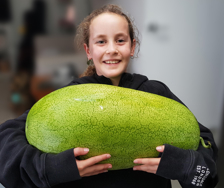Yates Account
Join now
Create a Yates account today!
Sign up to join the Yates Garden Club for monthly e-mails packed with seasonal inspiration, tips for success & exclusive promotions.
Plus if you’re a Garden Club member you can take part in the Yates Growing Community - a blog to share successes, get advice & win prizes in fun challenges along the way!

Forgot password
Enter the email address associated with your account, and we'll email you a new password.

There are many, many reasons to grow wildflowers – aside from the fact that they look gorgeous, wildflowers provide food and habitats for a diverse range of beneficial insects. Speaking for the vegie gardeners among us, you can’t have too many pollinators visiting your garden!
Most of our favourite vegies rely on insects to pollinate them. Native bees, honeybees, flies, hoverflies, butterflies and moths all adore flowers and if you can attract them into your garden you are creating a mutually beneficial gardening relationship. In fact, the more diversity you can create in your garden, the healthier your plants will be (because the pollinators always bring their little friends along; hungry predators of the pest insects that plague your plants).
Going back to the fact they look gorgeous, looking out at a meadow of vibrant colour lifts the spirits. Coming home to decompress in your own wild garden haven, humming with bees, is a wonderful stress reducer.

How to grow Wildflowers
Wildflowers are incredibly easy to sow and care for - simply clear a patch of soil, sprinkle the seed and rake in gently. Our wildflower mixes will self-seed and bloom in a constantly evolving display through the year.
You don’t need a large space for wildflowers (although they look spectacular if you do). You can sow them into nooks and corners and they’ll fill the space with exuberant colour. You can even sow patches or strips of wildflowers in amongst your vegies to improve pollination and yields. This is a great use for Yates Edible Flower Mix, so you can harvest both vegies and flowers for the table!
We’ve chosen flower blends that don’t all flower at once, so you always have different colours and scents unfolding. This creates forage for pollinators year-round.
We have created two Wildflower blends especially for feeding pollinators: Yates Bee Pasture and Yates Butterfly Field include all the tastiest favourite flowers to tempt them.
If you’re keen on a cheerful kaleidoscope of colour, Yates Wildflower Meadow or Yates Village Green Border Mix will hit the spot.
For the places in your garden with challenging conditions, try Yates Shady Woodland or Yates Tough & Hardy Wildflower Mix.
For a more coordinated field of colour, try the delightful Carpet of Blue, lustrous Carpet of Pinks, or the fabulously vibrant Mexican Fiesta Mix, which is hand-picked from our favourite Central American flower species.

Wildflower Care & Feeding
Wildflowers really benefit from digging in some Yates Thrive Natural Blood & Bone into their soil before sowing. You can keep the flowers looking good by removing dead blooms, cutting back leggy plants and feeding with Yates Thrive Rose & Flower Granular Plant Food.
There are a couple of cautions; unless it’s Yates Edible Flower Mix, don’t eat the flowers. Also, we don’t recommend any of these mixes for areas where livestock (ruminants and horses) are grazing – to be on the safe side.
















Share
Share this article on social media